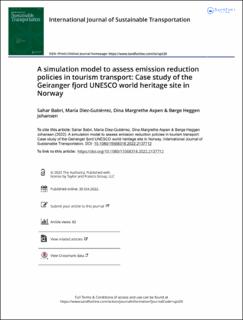| dc.contributor.author | Babri, Sahar | |
| dc.contributor.author | Diez Gutierrez, Maria | |
| dc.contributor.author | Aspen, Dina Margrethe | |
| dc.contributor.author | Johansen, Børge Andreas Heggen | |
| dc.date.accessioned | 2023-01-11T20:53:58Z | |
| dc.date.available | 2023-01-11T20:53:58Z | |
| dc.date.created | 2022-11-02T22:43:20Z | |
| dc.date.issued | 2022 | |
| dc.identifier.issn | 1556-8318 | |
| dc.identifier.uri | https://hdl.handle.net/11250/3042819 | |
| dc.description.abstract | Tourism transport may lead to significant air emissions and congestion problems on road networks. This is particularly troublesome for nature-based tourism destinations, as they often are in rural areas with low transportation capacities and vulnerable nature. Tourism transport systems are poorly understood, especially multi-modal systems with land and sea dynamics. In this article, we propose a multi-modal transport model that integrates traffic both at land and sea generated by tourism. The model was built on data from an in-situ questionnaire and validated with traffic counts and video recordings for the Geiranger fjord UNESCO world heritage site in Norway. Following a parliament decision to eliminate emissions from sea traffic, four emission reduction scenarios were explored. Results show that cruise-generated tourist buses may significantly contribute to air emissions and the formation of road congestion and emphasize the necessity of having a holistic approach in analyzing consequences of emission reduction policies for tourism transport. The model may be used in transportation planning and policymaking to assess alternative pathways to sustainable tourism transport. | en_US |
| dc.language.iso | eng | en_US |
| dc.publisher | Taylor and Francis Group | en_US |
| dc.rights | Navngivelse 4.0 Internasjonal | * |
| dc.rights.uri | http://creativecommons.org/licenses/by/4.0/deed.no | * |
| dc.title | A simulation model to assess emission reduction policies in tourism transport: Case study of the Geiranger fjord UNESCO world heritage site in Norway | en_US |
| dc.title.alternative | A simulation model to assess emission reduction policies in tourism transport: Case study of the Geiranger fjord UNESCO world heritage site in Norway | en_US |
| dc.type | Journal article | en_US |
| dc.type | Peer reviewed | en_US |
| dc.description.version | publishedVersion | en_US |
| dc.source.journal | International Journal of Sustainable Transportation | en_US |
| dc.identifier.doi | 10.1080/15568318.2022.2137712 | |
| dc.identifier.cristin | 2068308 | |
| cristin.ispublished | true | |
| cristin.fulltext | original | |
| cristin.qualitycode | 1 | |

